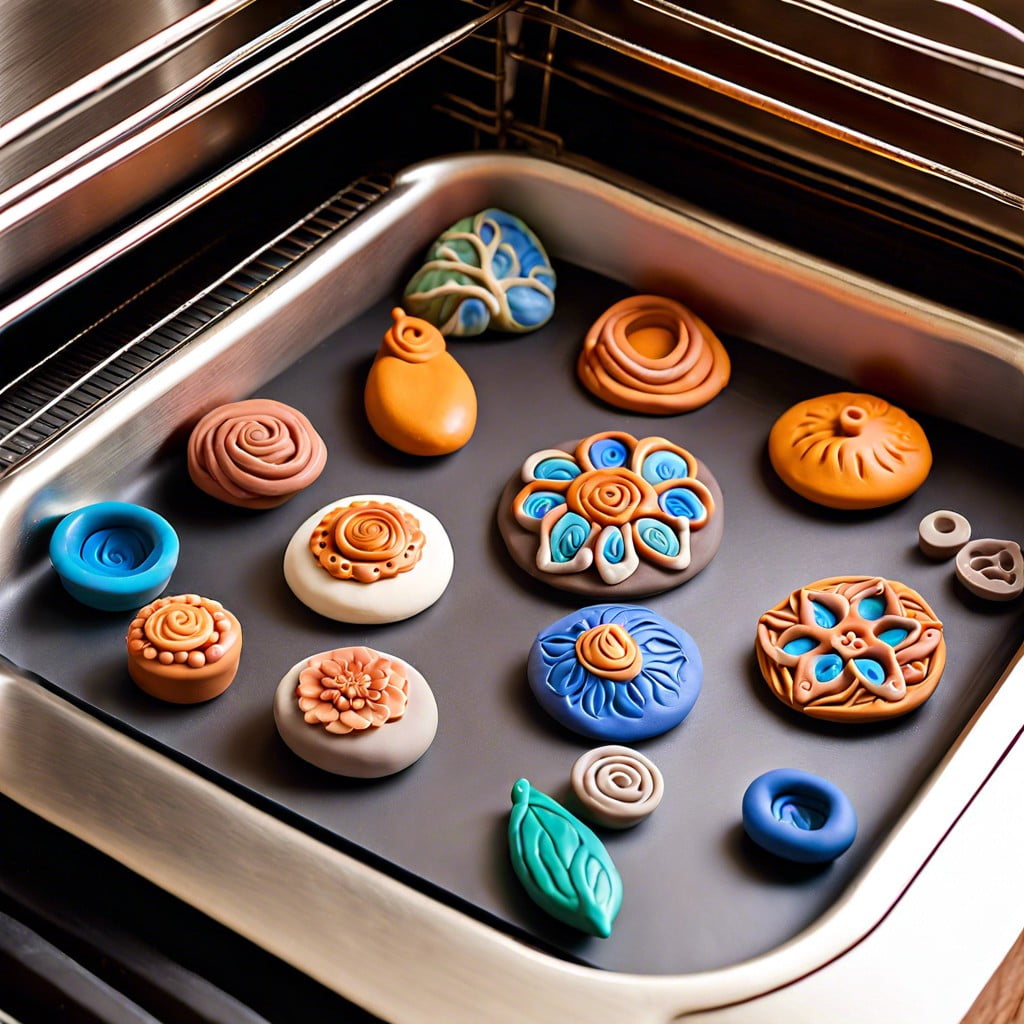Discover the optimal temperature for baking polymer clay to achieve perfect results every time.
Key takeaways:
- Optimal temperature for baking polymer clay: 265-275°F (129-135°C)
- Use an oven thermometer for accurate temperature control
- Baking time: 15 minutes per 1/4 inch of thickness
- Different ovens require different baking techniques
- Guidelines for baking special shapes and sizes
What Temperature Should You Bake Polymer Clay?

The ideal temperature for baking polymer clay is generally between 265 and 275 degrees Fahrenheit (129 – 135 degrees Celsius). Specific brands may have their own recommended temperature settings, which are typically printed on the packaging. It’s crucial to not exceed these recommendations because too much heat can cause discoloration, bubbling, or even burning of the clay.
An oven thermometer is a valuable tool as most ovens are not perfectly calibrated, ensuring you bake at the correct temperature. If yours runs hot or cold, adjust the settings accordingly to achieve the optimal temperature.
Remember, temperature accuracy is key for successfully curing polymer clay, providing the desired strength and durability to your creation. Always check the manufacturer’s instructions and use a thermometer for best results.
How Long to Bake Polymer Clay
Determining the correct baking time is crucial for achieving the best results with polymer clay. Generally, the baking time can vary based on the thickness of your project. For most brands, a good rule of thumb is to bake for 15 minutes for every 1/4 inch of thickness.
It’s important to follow the manufacturer’s instructions, as some clays may have different time and temperature requirements. Use an oven thermometer to ensure your oven is at the correct temperature before you start, as ovens can be inaccurate.
Uneven baking can lead to brittle projects, so make sure your pieces are evenly spaced in the oven. Also, tenting aluminum foil over your creations can prevent them from burning or discoloring.
If you’re working with larger or more complex items, consider baking in multiple stages. Begin with a shorter initial bake to set the shape, then add details and bake again to fully cure. This approach helps maintain the integrity of your design.
Always remember that insufficient baking will leave the clay vulnerable to breaking, while over-baking can cause discoloration or burning. If in doubt, it’s better to bake for a longer time at a lower temperature than to bake quickly at a high temperature.
Types of Ovens
Different ovens can affect the way polymer clay bakes, so it’s essential to understand how to use them effectively.
Conventional home ovens are the most commonly used for baking polymer clay. They are convenient, but the temperature can fluctuate, so an oven thermometer is vital to ensure the correct baking temperature is maintained.
Toaster ovens are a popular choice for crafters due to their compact size and ease of use. However, due to the smaller space, they can sometimes bake less evenly than larger ovens. It’s important to preheat them and possibly adjust the baking time.
Convection ovens offer more uniform heat distribution due to the built-in fan that circulates air. This can lead to more consistent baking results; however, they can also dry out the clay faster, which might slightly reduce the baking time.
Regardless of the type of oven, always place the polymer clay in the center of the oven to achieve the most even baking conditions. It’s also beneficial to place a piece of parchment paper or a ceramic tile beneath the clay to prevent scorching and to maintain a stable temperature surface.
Guidelines for Baking Special Shapes and Sizes
When baking special shapes and sizes of polymer clay, certain considerations can ensure even curing and prevent distortion:
- Thin or delicate pieces require a supportive structure during baking, such as a bed of cornstarch or a folded paper towel to maintain shape.
- Larger or thicker creations may need a lower temperature and a longer baking time to cure thoroughly without cracking.
- Using an oven thermometer is crucial, as internal oven temperatures can vary, affecting the baking process.
- It’s advisable to tent large or dark-colored items with aluminum foil to prevent scorching due to overexposure to heat.
- For beads or items with holes, suspending them on a rod or a piece of wire can prevent flat spots and ensure an all-around cure.
- Embedding wire or armature inside larger pieces can help them maintain their integrity during and after baking.
By attending to the unique needs of each form, artists and hobbyists can optimize the durability and appearance of their polymer clay projects.
Recap




